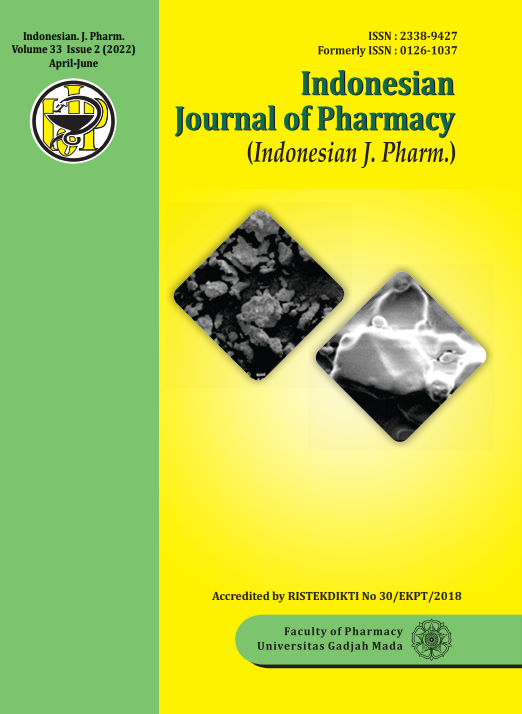Formulation And Optimization Peel-Off Gel Mask with Polyvinyl Alcohol and Gelatin Based Using Factorial Design from Banana Peel Flour (Musa paradisiaca L) As Antioxidant
Abstract
Banana peel (Musa paradisiaca L) contains flavonoid compounds that act as an antioxidant that has the potential to be developed into cosmetic preparations such as peel-off gel masks. This study aims to determine the effect of variations in the concentration of banana peel flour, PVA, and gelatin on the physical properties of peel-off gel masks and to determine their antioxidant activity. This study uses a factorial design of 23 where the factors used are the concentration of banana peel flour, PVA, and gelatin with 2 levels. Based on the results of data analysis, it was found that there was a significant effect of each factor and the interaction between factors on the spreadability and drying time of the preparation (p<0.05). F5 with a concentration ratio of banana peel flour, PVA, and gelatin of 5:12:5 was chosen as the optimum formula and continued to antioxidant activity test compared to F4 which had a ratio of concentrations of banana peel flour, PVA, and gelatin of 10:14:3. The antioxidant activity produced by F5 was better than F4 with IC50 values of 525.41 and 355.64 ppm, respectively. It can be concluded that the optimization of the dosage formula will affect the activity of the active substance.
References
Bennett RN, Shiga TM, Hassimotto NMA, Rosa EAS, Lajolo FM, and Cordenunsi BR. 2010. Phenolics and antioxidant properties of fruit pulp and cell wall fractions of postharvest banana (Musa acuminata Juss.) cultivars. Journal of Agricultural and Food Chemistry. 58 (13): 7991–8003. (https://doi.org/10.1021/jf1008692)
Beringhs AO, Rosa JM, Stulzer HK, Budal RM, and Sonaglio D. 2013. Green Clay and Aloe vera Peel-off Facial Maks Respons Surface Metdhology Apllied to the Formulation Design. AAPS PharmSciTech. 14 (1): 445-445. (https://doi.org/10.1208/s12249-013-9930-8).
Douguet M, Picard C, Savary G, Merlaud F, Loubat-Bouleuc N, and Grisel M. 2017. Spreading properties of cosmetic emollients: Use of synthetic skin surface to elucidate structural effect. Colloids and Surfaces B: Biointerfaces. 154: 307-314. (https://doi.org/10.1016/j.colsurfb.2017.03.028).
Emaga TH, Andrianaivo RH, Wathelet B, Tchango JT, and Paquot M. 2007. Effects of the stage of maturation and varieties on the chemical composition of banana and plantain peels. Food Chemistry. 103 (2): 590–600. (https://doi.org/10.1016/j.foodchem.2006.09.006)
Grace F, Darsika C, Sowmya V, Afker A, and Shanmuganathan S. 2015. Preparation and Evaluation of Herbal Dentifrice. International Research Journal of Pharmacy. 6 (8): 509–511. (https://doi.org/10.7897/2230-8407.068102)
González-Montelongo R, Lobo MG, González M. 2010. Antioxidant activity in banana peel extracts: Testing extraction conditions and related bioactive compounds. Food Chemistry. 119 (3): 1030–1039. (https://doi.org/10.1016/j.foodchem.2009.08.012)
Hadisoewignyo L, Foe K, Tjandrawinata RR. 2017. Isolation and characterization of Agung banana peel starch from East Java Indonesia. International Food Research Journal. 24 (3): 1324-1330.
Hamid AA, Aiyelaagbe, Usman LA, Ameen OM, and Lawai A. 2010. Antioxidant its Medicinal and Pharmacological Applications. Afr. J. Pure and Applied Chem. 4 (8): 142-151. (https://doi.org/10.5897/AJPAC.9000020)
Hernández-Carmona F, Morales-Matos Y, Lambis-Miranda H, and Pasqualino J. 2017. Starch extraction potential from plantain peel wastes. J. Environ. Chem. Eng. 5 (5): 4980–4985. (https://doi.org/10.1016/j.jece.2017.09.034)
Indarti K, Apriani EF, Wibowo AE, and Simanjuntak P. 2019. Antioxidant Activity of Ethanolic Extract and Various Fractions from Green Tea (Camellia sinensis L.) Leaves. Pharmacognosy Journal. 11 (4): 771-776. (https://doi.org/ 10.5530/pj.2019.11.122).
Kalariya PD, Namdev D, Srinivas R, and Gananandhamu S. 2017. Application of experimental design and response surface technique for selecting the optimum RP HPLC conditions for the determination of moxifloxacin HCl and ketorolac tromethamine in eye drops. Journal of Saudi Chemical Society. 21 (1): 373-382. (https://doi.org/10.1016/j.jscs.2014.04.004).
Kathe K, and Kathpalia H. 2017. Film forming systems for topical and transdermal drug delivery. Asian journal of pharmaceutical sciences. 12 (6): 487–497. (https://doi.org/10.1016/j.ajps.2017.07.004)
Kevers C, Falkowski M, Tabart J, Defraigne JO, Dommes J, and Pincemail J. 2007. Evolution of antioxidant capacity during storage of selected fruits and vegetables. J. Agric. Food Chem. 55 (21): 8596–8603. (https://doi.org/10.1021/jf071736j)
Marin E, Rojas J, Ciro Y. 2014. A Review of Polyvinyl Alcohon Derivates: Promising Materials for Pharmaceutical and Biomedical Application. African Journal of Pharmacy and Pharmacology. 8 (24): 674-684. (https://doi.org/DOI: 10.5897/AJPP2013.3906)
Ministry of Health of the Republic of Indonesia. Parameter Standar Umum Ekstrak Tumbuhan Obat. Jakarta: Ministry of Health of the Republic of Indonesia; 2000.
Molyneux P. 2004. The Use of the Stable Free Radical Diphenylpicrylhydrazyl (DPPH) for Estimating Antioxidant Activity. Songklanakarin. 6 (2): 211-219.
Nguyen TBT, Ketsa S, and Van Doorn WG. 2003. Relationship between browning and the activities of polyphenol oxidase and phenylalanine ammonia lyase in banana peel during low temperature storage. Postharvest Biology and Technology. 30 (2): 187–193. (https://doi.org/10.1016/S0925-5214(03)00103-0)
Rahmawanty D, Yulianti N, Fitriana M. 2015. Formulation and evaluation the peel-off face mask contains quercetin with variations concentrations of gelatin and glycerin. Med Farm.12 (1): 17-32.
Rum IA, Suherman HW, Idar. 2021. Formulation and evaluation of peel-off gel mask from whole milk yogurt and seaweed (Eucheuma cottonii) as antioxidants sources. Pharmacy & Pharmacology International Journal. 9 (4): 132-135. (https://doi.org/ 10.15406/ppij.2021.09.00338)
Saravanan K, and Aradhya SM. 2011. Polyphenols of pseudostem of different banana cultivars and their antioxidant activities. Journal of Agricultural and Food Chemistry. 59 (8): 3613–3623. (https://doi.org/10.1021/jf103835z)
Someya S, Yoshiki Y, and Okubo K. 2002. Antioxidant compounds from banana (Musa Cavendish). Food Chemistry. 79 (3): 351-354. (https://doi.org/10.1016/S0308-8146(02)00186-3)
Sulaiman SF, Yusoff NAM, Eldeen IM, Seow EM, Sajak AAB, Supriatno, and Ooi KL. 2011. Correlation between total phenolic and mineral contents with antioxidant activity of eight Malaysian bananas (Musa sp.). Journal of Food Composition and Analysis. 24 (1): 1–10. (https://doi.org/10.1016/j.jfca.2010.04.005)
Vieira R, Fernandes A, Kaneko T, Consiglieri V, Pereira C, Baby A, and Velasco M. 2009. Physical and Physicochemical Stability Evaluation of Cosmetic Formulations Containing Soybean Extract Fermented by Bifidobacterium Animalis. Brazilian Journal of Pharmaceutical Sciences. 45 (3): 515-525. (https://doi.org/10.1590/S1984-82502009000300018)








